Aberdyfi
| Aberdyfi | |
.jpg) View of Aberdyfi from Penhelig |
|
 Aberdyfi |
|
| Population | 1,282 (2011)[1] |
|---|---|
| OS grid reference | SN615965 |
| Community | Aberdovey |
| Principal area | Gwynedd |
| Ceremonial county | Gwynedd |
| Country | Wales |
| Sovereign state | United Kingdom |
| Post town | ABERDYFI / ABERDOVEY |
| Postcode district | LL35 |
| Dialling code | 01654 |
| Police | North Wales |
| Fire | North Wales |
| Ambulance | Welsh |
| EU Parliament | Wales |
| UK Parliament | Dwyfor Meirionnydd |
| Welsh Assembly | Dwyfor Meirionnydd |
Coordinates: 52°32′38″N 4°02′38″W / 52.544°N 4.044°W
Aberdyfi (English: Mouth of the River Dyfi), or Aberdovey (the Anglicised spelling is still in common use) is a village and community on the north side of the estuary of the River Dyfi in Gwynedd, on the west coast of Wales.
The village was founded around the harbour and shipbuilding industry, but is now best known as a seaside resort with a high quality beach.[2][3] The town centre is on the river and seafront, around the original harbour, jetty and beach but it stretches back from the coast and up the steep hillside in the midst of typical Welsh coastal scenery of steep green hills and sheep farms. Penhelig, with its own railway station, is the eastern part of the town.
Aberdyfi is a popular tourist attraction, with many returning holidaymakers, especially from the metropolitan areas of England, such as the West Midlands, which is less than 100 miles to the east. A relatively large proportion of houses in the village are now holiday homes, resulting in high house prices. The town is located within the Snowdonia National Park. In the 2011 census, 38.5% of the population of Aberdyfi ward identified themselves as Welsh (or combined).[1]
History
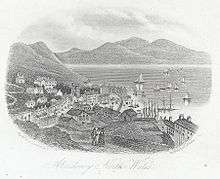
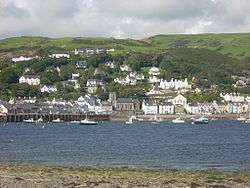
Local tradition suggests that the Romans established a track into Aberdyfi as part of the military occupation of Wales around AD78.[4]
The strategic location in mid-Wales was the site of several conferences between north and south Wales princes in 540, 1140, and for the Council of Aberdyfi in 1216. The hill in the centre of Aberdyfi, Pen-y-Bryn, has been claimed to be the site of fortifications in the 1150s, which were soon destroyed.[4] The site of Aberdyfi Castle however is usually said to be at the motte earthworks further up the river near Glandyfi.[5]
During the Spanish Armada of 1597, a Spanish ship, the Bear of Amsterdam missed her objective at Milford Haven and ended up having entered the Dyfi estuary. She was unable to leave for 10 days because of the wind and could not be boarded as no suitable boats were available.[4] An attempt to burn her was frustrated by winds and when she did leave she ended up being captured by a waiting English fleet off the Cornish coast.[6]
In the 1700s, the village grew with the appearance of several of the inns still in current use (The Dovey Hotel, Britannia and Penhelig Arms). Copper was mined in the present Copperhill Street, and lead in Penhelig.
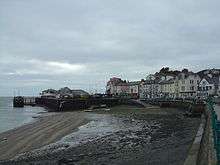
Governance
An electoral ward in the same name exists. This ward stretches inland along the A494 road and includes Pennal community. The total population of the ward taken at the 2011 census was 1,282.[1]
Port and railway
In the 1800s, Aberdyfi was at its peak as a port. Major exports were slate and oak bark. Ship building was based in seven shipyards in Penhelig where 45 sailing ships were built between 1840 and 1880.[4]
The railway came to Aberdyfi in 1863 built by the Aberystwyth and Welsh Coast Railway. The first train was ferried across the River Dyfi, as the line to Dovey Junction and then Machynlleth was not completed until 1867. Due to public demand, this section had to use a long tunnel behind Aberdyfi, and further major earthworks and tunnels were needed along the bank of the river. This line, which became part of the Cambrian Railways, and later the Great Western Railway, is particularly scenic.[7]
A jetty was built in 1887, with railway lines connecting it with the wharf and the main line. The Aberdyfi & Waterford Steamship Company imported livestock from Ireland which were then taken further by the railway. Coal, limestone and timber were also imported.
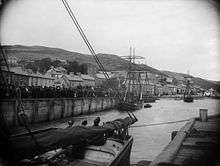
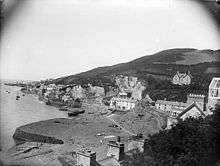
Local coastal shipping links with Liverpool were strong, with many Aberdyfi men sailing on international voyages from Liverpool. The S.S. Dora was one of the last ships trading between Aberdyfi and Liverpool and was scuttled, with no loss of life, by a German submarine in 1917.[4]
The jetty and wharf continued in commercial use for coal until 1959. After prolonged negotiations, redevelopments from 1968–1971, including rebuilding the jetty, led to their present use mainly for recreational purposes.[4] Some local fishing still occurs.
The first ever Outward Bound centre was opened in Aberdyfi in 1941.[8] Many of their activities involve the river, boats and jetty.
Lifeboat
The first Aberdyfi lifeboat was bought in 1837. Run by the RNLI since 1853, it has taken part in many rescues, sadly sometimes with loss of life of crew members. The current lifeboat, an Atlantic 75, is housed in the boathouse by the jetty and is launched using a lifeboat tractor. Currently it is averaging about 25 emergency launches each year.[9]
Worship
There have been many chapels built in Aberdyfi. These include the Welsh Calvinistic Methodist chapel, the English Presbyterian chapel, the Wesleyan Methodist chapel, and the Welsh Independent congregational chapel. The (Anglican) Church in Wales is St Peter's.
Transport
Road access to Aberdyfi is by the A493, with Tywyn four miles to the north and Machynlleth 11 miles to the east. Aberdyfi is on the Cambrian Coast railway line. The village of Aberdyfi has two railway stations, Aberdovey and Penhelig. Trains on the Cambrian Line are operated by Arriva Trains Wales. The local bus service is operated by Lloyds Coaches with services to Tywyn, where a connection can be made for Dolgellau, and to Machynlleth, where connections are available to Aberystwyth.
A ferry used to operate across the Dyfi river to Ynyslas. The last ferryman was Ellis Williams.[10]
Recreation
Popular recreational activities focus on the beach and watersports, such as windsurfing, kitesurfing, fishing, crabbing, sailing, and canoeing on the estuary.[3]
- Activities in Aberdyfi
-
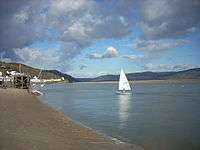
Sailing from Aberdyfi beach
-
A dinghy race in the Dyfi estuary
-
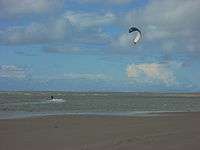
Kitesurfing on the Dyfi
-
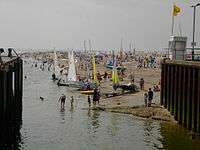
The beach on a busy Bank Holiday
The Dovey Yacht Club has a prominent position on the river front of the village. It was founded in 1949 and helped develop the popularity of the GP14 dinghy class.[11] It organises races for dinghies throughout the season on the estuary of the River Dyfi.
The Aberdovey Golf Club, founded in 1892, is a famous 18 hole links course located near the railway station. It is world-renowned, having been described frequently and lyrically in the press by Bernard Darwin, the famed golf writer, who was a notable member of the club. In 1895, it was the location of the first Welsh Golfing Union Championship. Current members include Ian Woosnam and Peter Baker.[12]
Located by the Aberdyfi Golf Club is Aberdyfi Football club boasting one of the best football pitches in Mid-Wales. The football team won the Welsh Amateur Cup Competition in 1934.[13]
The Aberdyfi Rowing Club rows in the Dyfi Estuary and Cardigan Bay and takes part in races all round the coast of Wales and internationally. They row 24’ long Celtic longboats, with four rowers (each with one oar) and a cox. They have three of these traditional Welsh boats with fixed seats and use these for races in Wales.[14]
The Aberdovey Literary Institute, founded in 1882, is situated on the river front. The deeds of 1923 state it was established in perpetuity as "a non-sectarian, non-political place of recreation, education and social intercourse including ... reading rooms, writing rooms, library, billiard rooms, concert rooms ..."
Neuadd Dyfi is a community hall, conference centre and theatre owned by the village for village activities. It caters for a range of local organisations and events.
Cultural References
The Bells of Aberdovey

Aberdyfi is closely linked to the legend of the submerged lost kingdom of Cantre'r Gwaelod (English: Lowland Hundred) beneath Cardigan Bay, and bells which, it is said, can be heard ringing beneath the water at the beach. The Bells of Aberdovey (in Welsh: Clychau Aberdyfi) is a well-known song referring to this legend. This song first appeared in the English opera Liberty Hall in 1785, written by Charles Dibdin, and is not thought to be a traditional folk-song as Welsh words were written by John Ceiriog Hughes, during the 19th century.
The legend and the song have inspired local cultural projects involving bells.
A new chime of bells was installed in September 1936 in the tower of St Peter's Church, which overlooks Aberdyfi harbour. The ten bells, tuned in the key of A flat, were specifically designed to allow the playing of The Bells of Aberdyfi and are played from a mechanical carillon inside the church.[15]

In 2010 an art installation was commissioned from sculptor Marcus Vergette as a homage to The Bells of Aberdovey. The work is a bronze time-and-tide bell suspended beneath Aberdyfi pier which is rung by the action of water at high tide. It was installed in July 2011 and is one of several such bells around the United Kingdom.[16][17]
The children's novel, Silver on the Tree, by Susan Cooper, the final book of The Dark is Rising, is largely set around Aberdyfi, with many references to local landmarks.
The novel, Megan's Game by Tony Drury, published in 2012, contains many references to Aberdyfi, surrounding areas and the legend of The Bells of Aberdovey.[18]
Notable people associated with Aberdyfi
- John Corbett (1817–1901), industrialist, philanthropist and Liberal Party politician
- James Atkin, Baron Atkin of Aberdovey (1867–1944), Barrister and Judge
- Oliver Onions (1873–1961), Novelist
- Berta Ruck (1878–1978), Romantic novelist
- Marguerite Florence Laura Jarvis (1886-1964), writer of romantic novels under many names (including Countess Barcynska), wrote the novel "Miss Venus of Aberdovey" and lived for a while at Panteidal Lodge
- Stan Hugill (1906–1992), Musician and artist, lived in Aberdyfi, and worked at the Outward Bound centre from 1950 to 1975
- Dr Thomas Tibbott Davies FRCS (1916–2007), local GP for many years[19]
- Christopher Riche Evans (1931–1979), psychologist, computer scientist, and author
- Sir John T. Houghton (born 1931), co-chair of the Intergovernmental Panel on Climate Change lives in Aberdyfi[20]
- Kenneth O. Morgan, Baron Morgan of Aberdyfi, (born 1934), Historian and author
- Sir Simon Jenkins (born 1943), Journalist, editor, author, chairman of the National Trust
- Jimmy Page (born 1946), with Robert Plant (born 1948), composed many Led Zeppelin songs at nearby Bron-Yr-Aur cottage
- David Gill (born 1957), former chief executive of Manchester United and a vice chairman of The Football Association owns a house in the village and is a member of Aberdovey Golf Club
- Tom Cave (born 1991), rally driver

References
- 1 2 3 "Neighbourhood statistics". Office for National Statistics. Retrieved 14 May 2015.
- ↑ "Aberdyfi.org". Retrieved 23 April 2011.
- 1 2 "Aberdyfi.com". Retrieved 23 April 2011.
- 1 2 3 4 5 6 Lewis, Hugh (1997). Aberdyfi: a chronicle through the centuries. Aberdyfi: Author.
- ↑ "Aberdyfi Motte". Archived from the original on 14 May 2011. Retrieved 24 April 2011.
- ↑ Pickering, W (1932). Archaeologia Cambrensis, Volume 87. Cambrian Archaeological Association. p. 392.
- ↑ Christiansen, Rex & Miller, R.W. The Cambrian Railways, Vol. 1 David & Charles (1967)
- ↑ Outward Bound International. http://www.outwardbound.net/about-us/history/the-birth-of-outward-bound/. Retrieved 10 October 2014.
- ↑ "Aberdyfi Lifeboat". Retrieved 24 April 2011.
- ↑ "The Williams Family Tree". Retrieved 24 April 2011.
- ↑ "Dovey Yacht Club". Retrieved 24 April 2011.
- ↑ "Aberdovey Golf Club". Archived from the original on 30 April 2011. Retrieved 24 April 2011.
- ↑ "FAW Welsh Trophy - over 100 years of history". Retrieved 23 April 2011.
- ↑ "Aberdyfi Rowing Club". Retrieved 24 April 2011.
- ↑ "About us". St Peter's Church website. Archived from the original on 26 April 2012. Retrieved 3 January 2012.
- ↑ "New bell rings as the tide rises in Aberdyfi, Gwynedd". BBC News. 12 July 2011. Retrieved 3 January 2012.
- ↑ "Time and Tide Bell". Marcus Vergette official website. Retrieved 3 January 2012.
- ↑ "City veteran wields pen against dodgy brokers". The Telegraph. 17 May 2012. Retrieved 28 October 2014.
- ↑ The Royal Society of Medicine Wall of Honour Archived 16 January 2014 at the Wayback Machine.
- ↑ "Scientist's climate change honour". BBC. 16 January 2006. Retrieved 28 October 2014.
External links
| Wikimedia Commons has media related to Aberdyfi. |
| Wikivoyage has a travel guide for Aberdyfi. |
-
 "Aberdovey". Encyclopædia Britannica (11th ed.). 1911.
"Aberdovey". Encyclopædia Britannica (11th ed.). 1911. - Aberdyfi.org Tourism website
- BBC Aberdyfi site
- BBC Cantre'r Gwaelod legends site
- www.geograph.co.uk : photos of Aberdyfi and surrounding area
- Snowdonia 360: Aberdovey Virtual Tour
